
Beginning in late 2002 and continuing after the 2003 invasion of Iraq, large-scale protests against the Iraq War were held in many cities worldwide, often coordinated to occur simultaneously around the world. After the biggest series of demonstrations, on February 15, 2003, New York Times writer Patrick Tyler claimed that they showed that there were two superpowers on the planet: the United States and worldwide public opinion.
Chicago Coalition Against War & Racism (CCAWR) was formed in September 2001 to protest the imminent United States invasion of Afghanistan. As of 2018, they had changed their name to Chicago Committee Against War and Racism. CCAWR gained a foothold in Chicago street politics and rose to prominence when it organized a rally at Federal Plaza the day after the U.S. invaded Iraq on March 20, 2003.

On 15 February 2003, a coordinated day of protests was held across the world in which people in more than 600 cities expressed opposition to the imminent Iraq War. It was part of a series of protests and political events that had begun in 2002 and continued as the invasion, war, and occupation took place. The day was described by social movement researchers as "the largest protest event in human history".

The proposed invasion of Afghanistan prompted protests with mass demonstrations in the days leading up to the official launch of the war on October 7, 2001. The continuation of the war in Afghanistan from 2001 to 2021 lead to further protest and opposition to hostilities.
The 1971 May Day protests against the Vietnam War were a series of large-scale civil disobedience actions in Washington, D.C., protesting the United States' continuing involvement in the Vietnam War. The protests began on Monday morning, May 3 and ended on May 5. In all, more than 12,000 people were arrested, in what was the largest mass arrest in U.S. history.
Campus Antiwar Network (CAN) is an American independent grassroots network of students opposing the occupation of Iraq and military recruiters in US schools. It was founded prior to the 2003 invasion of Iraq, and claims to be the largest campus-based antiwar organization in the United States.
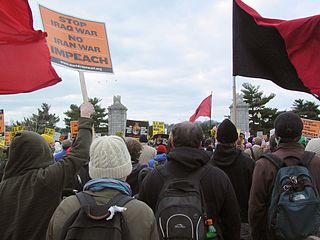
The March 17, 2007 anti-war protest was an anti-war demonstration sponsored by ANSWER Coalition that marched from Constitution Gardens in Washington, D.C. to The Pentagon in Arlington, Virginia. The date was selected to coincide with the fourth anniversary of the invasion of Iraq, and also the 40th anniversary of a similar anti-war march on October 21, 1967. Organizers estimated 15,000 to 30,000 protesters attended, while the police gave informal estimates of 10,000 to 20,000.

The September 15, 2007 anti-war protest was a march from the White House to the United States Capitol. It was organized by Veterans for Peace and the ANSWER Coalition. Volunteers were recruited for a civil disobedience action, which included a die-in. Volunteers signed up to take on the name of a soldier or civilian who died because of the war, and lay down around the Peace Monument. In attendance were public figures such as Cindy Sheehan and Ralph Nader. Police arrested more than 190 demonstrators who crossed police lines in front of the Capitol. Chemical spray was used by Capitol Police.
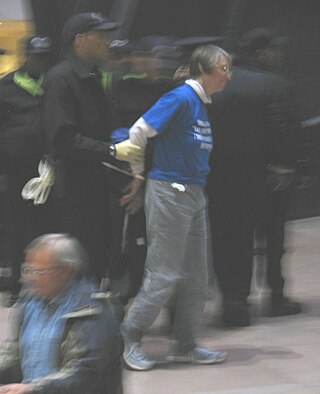
March 19, 2008, being the fifth anniversary of the United States 2003 invasion of Iraq and in protest and demonstration in opposition to the war in Iraq, anti-war protests were held throughout the world including a series of autonomous actions in the United States' capitol, Washington, D.C., in London, Sydney, Australia, and the Scottish city of Glasgow with the latter three being organized by the UK-based Stop the War Coalition. Actions included demonstrations at government buildings and landmarks, protests at military installations and student-led street blockades. The protests were notable, in part, for mostly replacing mass marches with civil disobedience – including religious-focused protests – and for utilizing new technologies to both coordinate actions and interface with traditional print and broadcast media.
Beginning on March 19, 2011, and continuing through the 2011 military intervention in Libya, anti-war protests against military intervention in Libya were held in many cities worldwide.
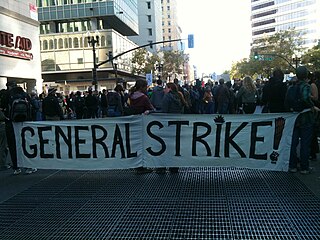
The 2011 Oakland general strike was a demonstration held in Oakland, California on November 2, 2011 as part of the larger Occupy Oakland movement.

Andy Thayer is an American socialist, LGBTQ rights and anti-war activist. He is co-founder of the Gay Liberation Network, one of the largest LGBTQ direction-action groups in Chicago. He is also the co-founder of Chicago Coalition Against War & Racism.

Protests against Donald Trump have occurred in the United States and internationally since his entry into the 2016 presidential campaign. Protests have expressed opposition to Trump's campaign rhetoric, his electoral win, his first inauguration, his alleged history of sexual misconduct and various presidential actions, most notably his travel ban in 2017 and aggressive family separation policy in 2018. Some protests have taken the form of walk-outs, business closures, and petitions as well as rallies, demonstrations, and marches. While most protests have been peaceful, actionable conduct such as vandalism and assaults on Trump supporters has occurred. Some protesters have been criminally charged with rioting. The largest organized protest against Trump was the day after his first inauguration; millions protested on January 21, 2017, during the Women's March, with each individual city's protest taken into consideration, makes it the largest single-day protest in the history of the United States. Following Trump's victory in the 2024 presidential election, a new wave of protests was held in reaction to his second presidency.

Numerous protests in opposition to Donald Trump took place during his candidacy then his presidency. The demonstrations were largely organized and made up of left-wing American citizens throughout the United States. Protests at times were attacked by Trump-supporters and sometimes violent towards Trump supporters.
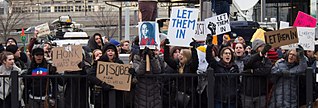
In late January and early February 2017, during protests against Executive Order 13769, commonly referred to as the “Muslim ban,” thousands of people gathered at various airports in the United States and around the world to protest the attempt by the Trump administration to prevent the prohibition refugees and visitors from seven countries considered by the administration to be unsafe. According to various sources, more than two thousand people were at the protest at John F. Kennedy International Airport in Queens, New York City with other protests appearing at significant international airports and other important sites around the United States. Protests continued daily and internationally through February 6. Protests also continued after a federal judge issued a temporary restraining order against parts of the travel ban.
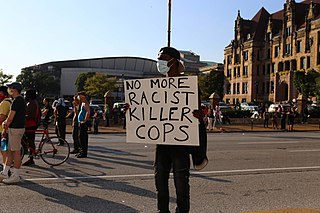
Beginning on the afternoon of September 15, 2017, a series of protests took place in St. Louis, Missouri, following the acquittal of former St. Louis police officer Jason Stockley in the shooting of Anthony Lamar Smith, a black man. Over 160 people were arrested during the first three days of demonstrations, with largely peaceful protests. There has been significant criticism around the police and governmental response to protests, resulting in lawsuits from the ACLU.
Eugene has a long history of community activism, civil unrest, and protest activity. Eugene's cultural status as a place for alternative thought grew along with the University of Oregon in the turbulent 1960s, and its reputation as an outsider's locale grew with the numerous anarchist protests in the late 1990s. According to the Chicago Tribune, the city was called a "cradle to [the] latest generation of anarchist protesters." Occupy Eugene was home to one of the nation's longest-lasting Occupy protests in 2011, with the last protester leaving the initial Occupy camp on December 27, 2011. The city received national attention during the summer of 2020, after Black Lives Matter protests in response to the murder of George Floyd grew violent.

Protests, including rallies, demonstrations, campaigns, and vigils, relating to the Israel–Hamas war have occurred nationwide across the United States since the conflict's start on October 7, 2023, occurring as part of a broader phenomenon of the Israel–Hamas war protests around the world.
A series of pro-Palestinian protests were held in the United States on April 15, 2024.













